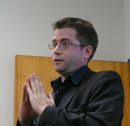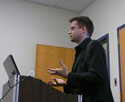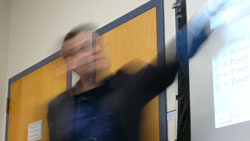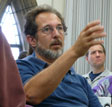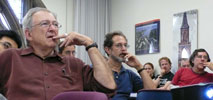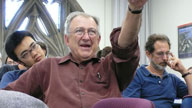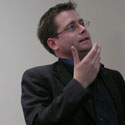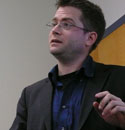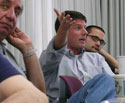

![]()
::: postdoc fellowships
::: senior fellowships
::: resident fellowships
::: associateships
![]()
being here
::: visiting
::: the last donut
::: photo album
::: center home >> being here >> last donut? >> 25 september 2007 |
Tuesday, 25 September 2007 Every region has its home grown industries. There are many in Pittsburgh. They extend from Carnegie's steel and Heinz's ketchup to more modern enterprises in software and medicine. Philosophically, an important home grown industry is causal discovery, centered among a decades long tradition of work at our neighboring Carnegie Mellon University's department of philosophy.
As our starting time approached, I noticed with pleasure that the core members were arriving: Richard Scheines, Peter Spirtes, David Danks; and there were many more in the room who had taken a very serious interest in causation and causal discovery. They included our local Jim Bogen and our Visiting Fellow Jim Woodward, who is advocating an interventionists view of causation that has attracted much attention. This is a formidable audience for anyone to face, let alone a young scholar from Switzerland, who had only recently completed his doctorate. I had a premonition that this much brain power could not sit quietly. Michael began his talk carefully, recounting a history that we all knew. There are many accounts of the nature of causation. His preferred account is a traditional "regularity" account. That view has a venerable lineage that can be traced to a patron saint of empiricist philosophy, David Hume. For Hume, that A causes B just meant that A is regularly followed by B. Later versions entwine this simple idea in a thicket of extra conditions, while preserving the essential empiricist commitment that actual facts exhaust the meaning of causal statements. Regularity accounts are contrasted with accounts that refer to counterfactuals. They add conditions like: ...and if A were not to happen, then B would not happen. Or there are interventionist accounts, in which we add that were A somehow to be altered, then there would be a corresponding change in B. Michael's historical remarks then turned to the work at CMU. Merely knowing that A causes B is only the start of the problem. What if we have a very complicated structure: A, B, C, ... and all sorts of causal relations between them. How might that manifest in the various occurrences of A, B, C, ... More importantly, if we just know those occurrences, how can we figure out the set of causal relations behind them? Michael's delivery was energetic. He moved rapidly between the lectern and the digital projector screen on his neat graphics provided pegs upon which to hang his sentences. Now Michael turned to what would prove to be the central problem of his talk. Take one set of facts. Whenever B happens, A and C always happens too. Can we know what causal structure lies behind it? One possibility is a chain: A causes B which then causes C. That, Michael calls a "causal chain," reflecting the way causes cascade through. Or we might have B causes A and C separately--picture it as a fork. That Michael calls a common cause structure. The facts do not let us distinguish between them. To take a prosaic example, we may notice the fact that people who watch lots of violent movies are more prone to violent behavior and to having a criminal record. Is it that watching the movies makes them prone to violence and then that leads to the criminal record? That is a chain. Or is it that people who incline to violent behavior are led by that proclivity both to watch violent movies and to a criminal record? That is a common cause. Of course Michael's examples are far more complicated and he begins to illustrate them with the case of five possibilities A, B, C, D and E. The momentum is building and I can sense that Michael's audience is getting a little restless at its direction. Richard interjects--no point in leaving important claims unclear. Just what does Michael intend when he "sets" the box with an A to red? What are you allowed to do with these variables. Michael is thrown and they trade query and counter query, with a growing sense that there's some basic presumption that had been overlooked. It took a few rounds before I saw it. Michael had mentioned that he was a regularity theorist, but I hadn't realized that this affiliation would be important to his talk. For him, notions like "setting" a variable A to "happens" is really just shorthand for saying that we found a real situation in which A actually happened. Richard, however, and the CMU group have a different conception of causation along the interventionist lines. For them, "setting" a variable is an intervention that amounts to building a little piece of another world in which things are different from what actually happened. If we intervene on A, they ask, what else should change and what should not? That is delicate surgery and must be dealt with in a controlled way by rules known to the initiates. For the regularity theorist, steeped in the good sense of empiricism, it is hard to make sense of the question. With Richard's intervention sorted out, Michael now had a clear sense that his audience was attending closely but not necessarily agreeing. He could sense that there were currents of thought in the room that would try to pull him in who knows what direction. Many speakers have come to that realization and an instinct for survival tells them to be careful. Michael returned to his talk and its overall structure emerged. He has precise results about when one gets these indistinguishable causal structures. Any chain, he asserts, will be equivalent in terms of what we can see in actual facts with some common cause structure. But the reverse is not true. You cannot always replace a common cause structure with a chain. That seemed a central and important result and I jotted it on my notepad. This central fact dominated the remainder of the talk. What, Michael now asks, might we add to our catalog of facts to enable us to discriminate between the different causal structures? Michael proceeded through a list of condidates, all given expression as some form of occurrent fact. Temporal order? Spatiotemporal proximity? Transference of a conserved quantity? All fail to be strong enough to disambiguate the different structures. Michael is now well into his talk. The familiar graphics of modern causation talks have been covering the screen. They are causal graphs, which look like blobs with letters inside connected by arrows. That is how most of us picture complicated causal structures. Those arrows are now starting to bother the audience more and more. There's an interjection again from one side of the room, trying to plumb just what these arrows might represent. If we have A --> B --> C, why not also put in A --> C? That sort of question is rarely simple curiosity. The questioner usually has a strong sense of what that arrow ought to mean; and why it should mean that; and what would go wrong if one doesn't see it just the way the questioner does. So it is rarely possible to deflect the question with a short sentence in mid talk. The chasm between the audience's interventionist idea of causation and Michael's regularity view is proving hard to bridge. When Michael's answer does not bridge it, variant forms of the same question start to fly in from different corners of the room. What does the arrow really mean, they insist. Michael does his best to swat them but the swarm is beginning to form. It was time to intervene and I invoked the organizer's privilege to clear the air and let Michael proceed. The talk wound to its conclusion. While we may not be able to distinguish causal chains from common cause structures, the chains have an explanatory advantage. If we consider larger bodies of fact, presuming the chain structure will let us predict features of how those facts must go. That brings Michael to his concluding message. We have no empirical justification for preferring causal chains over common causes, but we may nonetheless prefer them for their explanatory powers. The talk has run well over time because of the interventions, so I cut short the break before question time and try to settle everyone in for what I expect to be an energetic question time. Curiously the room is slow to start, but not for long. One repeated remark points out another chasm between the lectern and the audience. Michael's analysis took the case of deterministic relations: whatever causes some effect will always assuredly do so. The CMU group uses a different relation. Causes of some effect only raise the probability of its occurrence; they do not assure it. Those who work with this latter relation have long had to admit that strong results are easier to find for the deterministic case. In this instance, however, if one approaches causation probabilistically, the ambiguities that so troubled Michael would evaporate, they insist. For once, their system dodges the bullet. Michael let their point pass. When I asked him about it later, he immediately turned to illustrating cases where deterministic systems dodge the bullets that strike the probabilistic ones. He began to cover a scrap of paper with letters and arrows. I could sense him regretting that he had been too tired or too distracted at the end of his talk to make this speech there. The back and forth was proceeding energetically still at our immovable stopping time, when I called the proceedings to a halt and presented Michael with his umbrella. He had certainly earned it. He had faced a formidable audience and acquitted himself well. He was still smiling. John D. Norton Michael Baumgartner |
